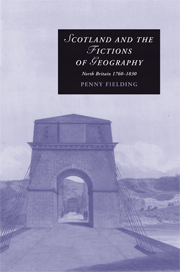Book contents
- Frontmatter
- Contents
- Acknowledgements
- Introduction
- 1 North Britain
- 2 Burns, place and language
- 3 Great North Roads: The geometries of the nation
- 4 Antiquarianism and the inscription of the nation
- 5 Ultima Thule: The limits of the north
- 6 Norths: James Hogg and post-Enlightenment space
- Notes
- Bibliography
- Index
- CAMBRIDGE STUDIES IN ROMANTICISM
Introduction
Published online by Cambridge University Press: 05 May 2010
- Frontmatter
- Contents
- Acknowledgements
- Introduction
- 1 North Britain
- 2 Burns, place and language
- 3 Great North Roads: The geometries of the nation
- 4 Antiquarianism and the inscription of the nation
- 5 Ultima Thule: The limits of the north
- 6 Norths: James Hogg and post-Enlightenment space
- Notes
- Bibliography
- Index
- CAMBRIDGE STUDIES IN ROMANTICISM
Summary
Arriving in Aberdeen in 1773, Samuel Johnson addresses his readers, the inhabitants of ‘our own island’:
To write of the cities of our own island with the solemnity of geographical description, as if we had been cast upon a newly discovered coast, has the appearance of very frivolous ostentation; yet as Scotland is little known to the greater part of those who may read these observations, it is not superfluous to relate that under the name of Aberdeen are comprised two towns standing about a mile distant from each other, but governed, I think, by the same magistrates.
For Johnson, the phrase ‘our own island’ does not denote equality of national belonging among a modern, educated readership. Scotland may as well be ‘a newly discovered coast’ for the majority of his readers, but it can be rescued from its state of primitive obscurity by ‘the solemnity of geographical description.’ The work of geography, then, will reveal not only Scotland's place in the Union but also its emergence, or discovery, as part of the modern, civilised world, here represented by the reassuring information that Aberdeen is legally regulated. It is through geography, in Johnson's mind, that Scotland can be understood as part of a national narrative and given form and function within British history.
- Type
- Chapter
- Information
- Scotland and the Fictions of GeographyNorth Britain 1760–1830, pp. 1 - 12Publisher: Cambridge University PressPrint publication year: 2008



